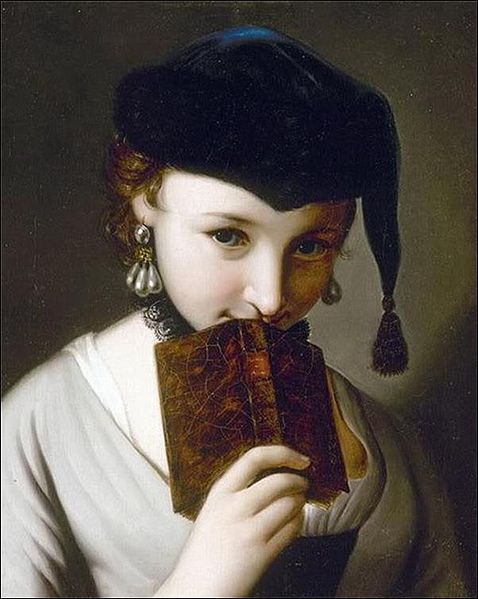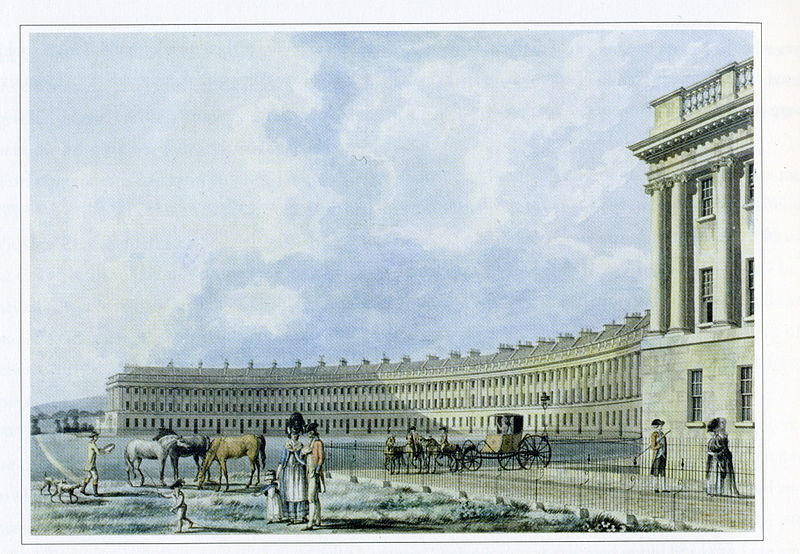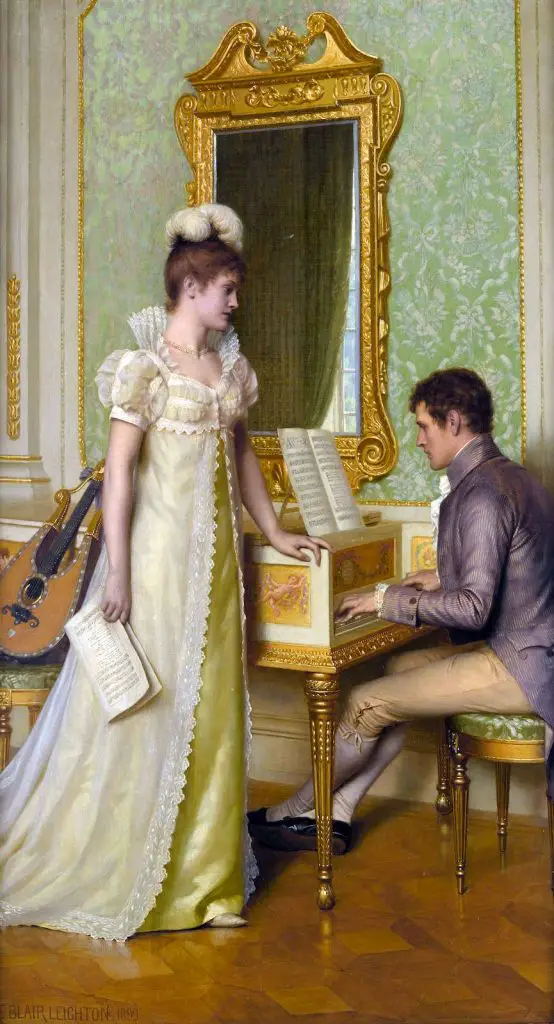Northanger Abbey Unit -- Wiebracht
Advanced Topics: Love Stories
Fall 2020
Dr. Wiebracht
Stanford Online High School
[Note: This page is intended for readers of the article "Teaching Nineteenth-Century Novels to Today's Teens" in Dickens Studies Annual (52.1). If you happened upon the page in some other way, you are still welcome to peruse it. For a description of the pedagogy that informs this unit, see the article, linked here.]
Unit 4: Love and the Novel

Girl with a Book, Pietro Rotari (image credit: Wikimedia Commons)
Week 1
Day 1: Welcome to Bath

"The Royal Crescent" (1780), Thomas Malton the younger (image credit: Wikimedia Commons)
- Before class:
- Read chapters 1-4
- Explore Georgian Bath (read up on one of the following -- or both!)
- Cards, balls, tea-time gossip, constant flirtation: all these delights and more await you in Bath! Click here to learn more about the social scene of this Georgian resort town.
- Are your nerves overwrought? Do you have a case of the vapours? Are you feeling gouty or rheumatic? Whatever your high-brow complaint, Bath has the cure! Click here to find out more about the healing waters of Bath.
- Writing:
- Provide a one-paragraph character portrait of Catherine Morland. What are her defining qualities? Then, think about her experience of Bath so far. How does Austen's picture of Bath compare with those of the external sources you read (discuss at least one of those sources)? Aim for about a page.
- In class:
- We'll discuss our first impressions of Catherine Morland and the city of Bath. In what way do both of these "characters" evade or overturn our expectations? In the case of Catherine, where did the reader's expectations come from in the first place?
Day 2: "Only a Novel"

Young Girl Reading (c. 1770), Jean-Honoré Fragonard (image credit: National Gallery of Art)
- Before class:
- Read chapters 5-9
- Check out these selections to find out more about the reputation of novels in the Austen's day. Austen would have been familiar with all these authors -- she actually praises the work of Burney and Edgeworth in her famous defense of the novel in Chapter 5.
- Excerpt from The Female Quixote (Charlotte Lennox, 1752)
- Curious whether Austen herself ever read this novel? Here's an excerpt from an unpublished novel she wrote when she was fifteen, Love and Freindship [sic]. You decide!
- Preface to Evelina (Fanny Burney, 1778)
- Advertisement for Belinda (Maria Edgeworth, 1801)
- Excerpt from The Female Quixote (Charlotte Lennox, 1752)
- In class:
- We'll pay especially close attention to Austen's defense of the novel at the end of Chapter 5. Based on that defense, and on the supplementary readings above, what do you think were the usual accusations leveled at novels? How does Northanger Abbey respond to those accusations, not just in that one famous passage, but through its plot and its norm-busting heroine? In the end, is Northanger Abbey a satire of novels, or a defense of them, or, somehow, both?
Week 2
Day 1: Excursions

Catherine and Henry walking (still from the 2007 Jon Jones adaptation)
- Before class:
- Read chapters 10-14
- Thorpe calls Blaize Castle "the oldest in the kingdom," with towers and galleries "by dozens." Try fact-checking those claims with a bit of googling. Then, once you've seen the real Blaize Castle, why do you think Austen chose it as the party's intended destination?
- Learn a little more about the "picturesque," a late-eighteenth century aesthetic ideal that Henry tries to explain to Catherine. The Tate museum in London has a good definition of the movement, with plenty of visual examples. Make sure to click the "See all artworks" link at the bottom of the page.
- Writing:
- In these chapters, Catherine makes a pair of excursions beyond Bath. Love stories, as we have already seen, often involve these rangings on the part of the heroine into a wider, more dangerous, more interesting world. What does Catherine discover in the course of these excursions? How is her character expanded or developed through them? Aim for about a page.
- In class:
- We'll discuss the discoveries Catherine makes in her two excursions beyond Bath -- about herself, about her friends in Bath, and about human nature generally. We'll also think about the picturesque as an artistic ideal. It applies most directly to landscape painting, but might Austen be invoking it to say something about the internal workings of her characters as well? Also, we need to dialogue about all this dialogue. Catherine often seems delighted and surprised by Henry's conversation. Why? What's different about it? What does Henry have that, say, her brother, Isabella, and Thorpe don't?
Day 2: Modesty

Yes or No? (1890), Edmund Blair Leighton (image credit: Sotheby's, private collection)
- Before class:
- Read ch. 15-19
- Learn about the complexities and contradictions of the late 18th c. code of modesty -- and its interesting role in the novel tradition.
- Ruth Bernard Yeazell, Fictions of Modesty, pp. 51-64. (not linked on this sample page for copyright reasons)
- Yours Truly, Cousins and Lovers, pp. 156-160.
- In class:
- In what ways does Catherine Morland fit the bill of a modest heroine? Does she ever violate the code, and if so, how do her fellow characters and the plot itself react? We'll talk about her attempts to figure out what's going on between Captain Tilney and Isabella from today's reading (potentially compromising knowledge), but we'll also look back at the means by which she smooths things over with Henry after missing their agreed-upon meeting. To what extent do Yeazell's and my arguments apply to this novel?
Week 3
Day 1: The Gothic
Arundel Castle, Sussex (image credit: hauntedisland.co.uk)
- Before class:
- Read Chapters 16-21
- Brush up on the Gothic! These selections will help give you the flavor of it (read/view at least three):
- Excerpt from The Castle of Otranto (1764), Horace Walpole
- Excerpt from The Mysteries of Udolpho (1794), Ann Radcliffe, pp. 235-240 in your Norton edition.
- Excerpt from The Monk (1796), Matthew Lewis
- Belle explores the West Wing (Beauty and the Beast, Disney, 1991)
- Writing: Think the Gothic is dead? Then let's bring it back, like Frankenstein's monster, in the form of a dozen grisly fragments! Write a 1-2 page Gothic scene or vignette. No need to give the whole backstory (though you can if you want); just throw us straight into the action. Parodies and earnest tributes to the genre are both welcome!
- In class:
- Northanger Abbey is perhaps best remembered as a "satire of the Gothic," and the reading for today explains why. Secret passageways, criminal lords, imperiled damsels -- those tropes, especially after they'd been recycled for a few decades, were easy targets for writers like Jane Austen. But is the relationship between Austen and the Gothic really so simple? Do the themes and concerns of the Gothic ever overlap with those of Northanger Abbey -- that is, in non-satirical ways?
Day 2: The Lord and Lady of the Manor

Prelude (1899), Edmund Blair Leighton (image credit: victorian-era.org)
- Before class:
- Read chapters 22-28
- Learn about the role of great estates in Georgian England
- Optional: If you're curious to learn more about the economic and political dimensions of this novel, check out Robert Hopkins' "General Tilney and Affairs of State" in your Norton edition, pp. 294-302.
- In class: Well, it turns out Northanger Abbey isn't quite as full of ghosts and secret passageways as Catherine was hoping. But that doesn't mean it's not interesting. We'll discuss the social function of great houses like Northanger Abbey. How does the management of these estates impact regular people -- small farmers, servants, etc? What kind of landlord is General Tilney specifically? And given the make-up of the general's family, what is likely to happen to the estate when it is passed down to the next generation?
Week 4
Day 1: Writing Back

(image credit: Jane Austen's World)
- Before class:
- Read chapters 29-31
- Read one of the modern critical selections from your Norton edition that we haven't read together (any of the selections from pp. 264-358).
- Writing: Respond to the critical view you read. You can agree or disagree or something in between -- but make sure to add something. Thus, even if you wholeheartedly agree with your critic's argument, see if you can carry their argument into new territory, perhaps by applying it to passages the author didn't consider, or by drawing on your knowledge of Northanger Abbey's cultural and literary context. Aim for about two pages.
- In class:
- You all will run the discussion today! You'll summarize the arguments of the critics you read, and the class will debate them.